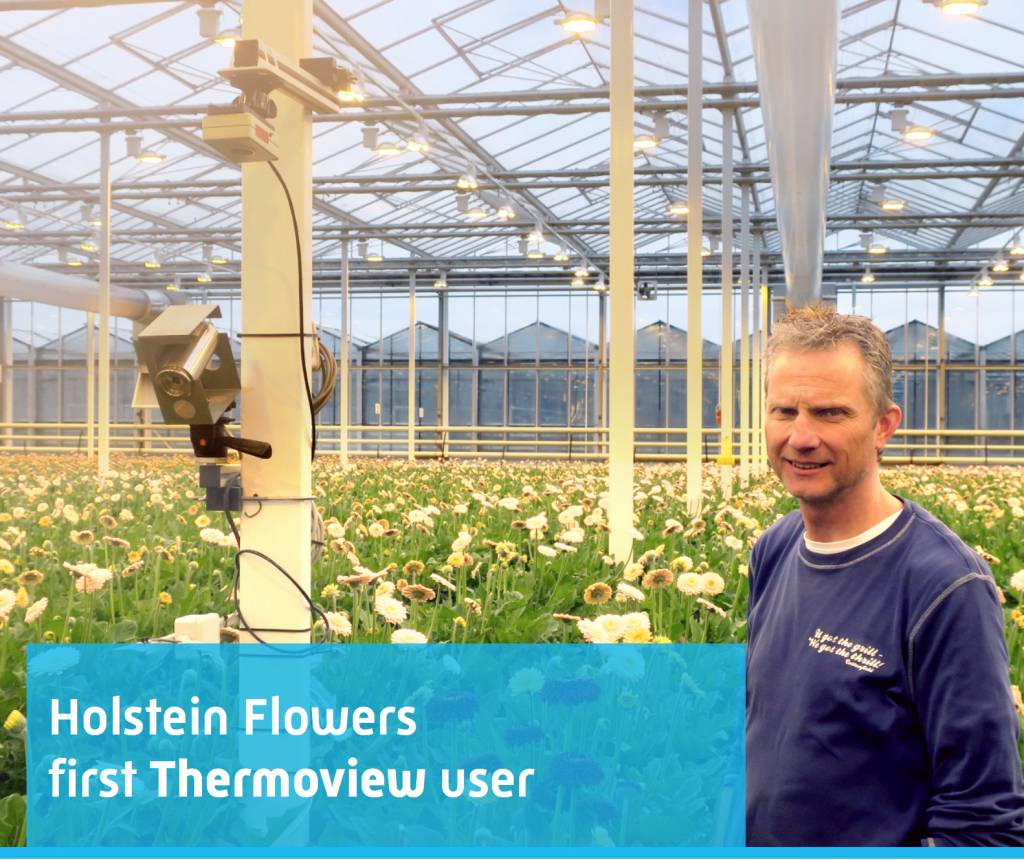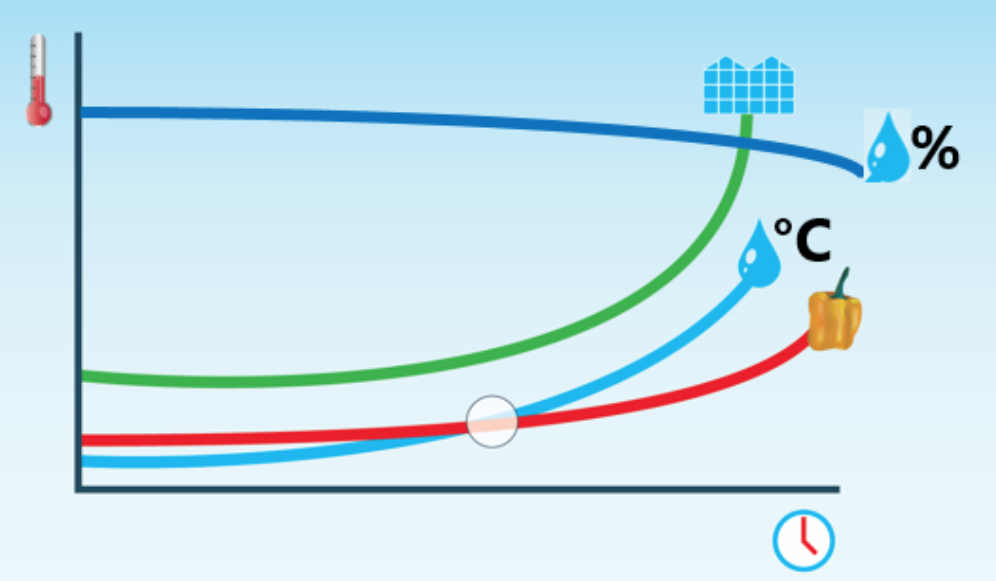Holstein Flowers first Thermoview user
- Geschrieben am
- Durch Hoogendoorn Growth Management
- 1

Holstein Flowers is the first company using Thermoview, the thermo camera measuring the real-time temperature of and
around the crop. Mathieu van Holstein is running the gerbera company in De Lier, the Netherlands, together with his 3
brothers and 2 cousins. The family business started in 1946 as a vegetable cultivation company.
Holstein Flowers is the first company using Thermoview, the thermo camera measuring the real-time temperature of and around the crop. Mathieu van Holstein is running the gerbera company in De Lier, the Netherlands, together with his 3 brothers and 2 cousins. The family business started in 1946 as a vegetable cultivation company. When Mathieu’s brothers joined the nursery they started looking for another type of crop and in 1974 the company switched to gerbera cultivation. Mathieu has been working in the company since 1988 and is responsible for cultivation, finance and administration.
Nowadays the company has grown to a total surface of almost 11 hectares, spread over two locations, and about 70 million stems are grown each year. Yet, with 6 Holstein-men working for the company, Holstein Flowers still is a real family business. Characteristic for the company is the own selection branch. “About 85% of the flower varieties we grow are of our own breed. This is what makes us unique and with which we distinguish ourselves in the market”, according to Mathieu. Next to that, the company also has a big focus on innovation. “In general we are one of the firsts to gain knowledge of new techniques, and when we think improvements are possible we also like to try out new things”.
Thermoview
 Thermoview is one of these new techniques Holstein Flowers is working with. At first they ran a trial for a year, in cooperation with Wageningen UR Greenhouse Horticulture, for a research project about Next Generation Growing. Meanwhile, this research has been completed and Holstein Flowers has now been operating their own Thermoview camera for about 3 months. An important reason for continuing the use of Thermoview is research about condensation. “When a gerbera gets wet because of condensation and stays wet for a longer time, botrytis can occur, which can cause us quality issues”, Mathieu says. To avoid condensation Holstein Flowers started to research evaporation a few years ago. However, evaporation equipment gives information about the evaporation, but this does not say anything about the extent to which the flower cools down. “A flower can lose warmth, but also takes in warmth from its surroundings. So when you know evaporation is increasing, you can suspect the flowers may cool down, but you cannot be sure”. For Holstein Flowers this was why they started to research thermal imaging techniques, to gain more insights in the real flower temperature, relative to the greenhouse temperature. With this desire in mind, Mathieu contacted the Hoogendoorn and LetsGrow.com consultants and decided to try out the Thermoview camera. “We are still learning to use Thermoview, but are happy with the instrument. We mostly measure the flower temperature by means of point measurements, but the Thermoview system also offers the possibility to measure the temperature of an area of a number of plants”. For Mathieu the biggest advantage of the Thermoview system is the insights it offers in the plant temperature and the changes of the plant temperature. This gives the opportunity for a quicker response, allowing the greenhouse climate to be controlled in a better way. This response used to be based on intuition, but is now supported by data.
Thermoview is one of these new techniques Holstein Flowers is working with. At first they ran a trial for a year, in cooperation with Wageningen UR Greenhouse Horticulture, for a research project about Next Generation Growing. Meanwhile, this research has been completed and Holstein Flowers has now been operating their own Thermoview camera for about 3 months. An important reason for continuing the use of Thermoview is research about condensation. “When a gerbera gets wet because of condensation and stays wet for a longer time, botrytis can occur, which can cause us quality issues”, Mathieu says. To avoid condensation Holstein Flowers started to research evaporation a few years ago. However, evaporation equipment gives information about the evaporation, but this does not say anything about the extent to which the flower cools down. “A flower can lose warmth, but also takes in warmth from its surroundings. So when you know evaporation is increasing, you can suspect the flowers may cool down, but you cannot be sure”. For Holstein Flowers this was why they started to research thermal imaging techniques, to gain more insights in the real flower temperature, relative to the greenhouse temperature. With this desire in mind, Mathieu contacted the Hoogendoorn and LetsGrow.com consultants and decided to try out the Thermoview camera. “We are still learning to use Thermoview, but are happy with the instrument. We mostly measure the flower temperature by means of point measurements, but the Thermoview system also offers the possibility to measure the temperature of an area of a number of plants”. For Mathieu the biggest advantage of the Thermoview system is the insights it offers in the plant temperature and the changes of the plant temperature. This gives the opportunity for a quicker response, allowing the greenhouse climate to be controlled in a better way. This response used to be based on intuition, but is now supported by data.
The future Mathieu is convinced technology will play an increasingly important role in the future of the horticultural sector. “Access to and costs of technology are becoming increasingly approachable. More and more sensors and such are being used, which will cause for greenhouse controls to be operated based on technology. With this we will eventually be able to regulate everything better”.
LetsGrow and Hoogendoorn Growth Management
LetsGrow.com and Hoogendoorn Growth Management jointly introduced Thermoview: a thermographic camera that measures the temperature of the crop and its surroundings. Thermoview can be used to measure the temperatures of fruits, flowers and plant leaves in real-time with one sensor. With this measurement, you can calculate the dew point, gain insight into vertical temperature differences, avoid condensation, prevent crop damage and prevent diseases. On the online LetsGrow.com platform, you can view the measurements in graphs and see photos in time-lapse. You can also combine this with data from your climate computer. By connecting information from both sources, you gain access to other real-time greenhouse data, such as the temperature and relative humidity.
Tip 1: Causes of condensation on your crop in the morning
In the morning many growers look at the RH course in the greenhouse to see if everything is going well. However, with a relatively low and falling RH level, it is still possible that you will find wet crop parts in your greenhouse. That is because condensation is not so much determined by the RH level, but by the dew point of the greenhouse air.
The temperature of the greenhouse air rises in the morning due to solar radiation. Due to this radiation the plants in the greenhouse evaporate more and hereby add humidity to the greenhouse air. This results in a rising dew point temperature. However, because more humidity can be absorbed in warmer greenhouse air, the RH level will remain the same or even decrease.

The heavier crop parts need more time to warm up than the greenhouse air and due to this they fall behind in temperature. Condensation will occur when the dew point of the greenhouse air rises faster than the temperature of the crop parts. This is shown in the graph below where the dew point line (light blue) crosses the fruit temperature line (red).
Tip 2: How to prevent crop condensation in the morning
It is important to ensure that your crop does not get wet due to condensation. In wet areas diseases and pests can grow quickly, causing higher infection pressure and loss of quality and production.
The dew point is the temperature at which water vapor will condense from the air. Condensation thus occurs when the temperature of the crop and / or fruits falls below the dew point temperature of the greenhouse air. To gain insight in the temperature of your crop and fruits you can use a thermal camera. The thermal image below shows a crop early in the morning, where it is clearly visible that the fruits are colder than the other parts of the crop.

There are two possible ways to prevent the occurrence of condensation: you can increase the crop/fruit temperature until it exceeds the dew point temperature of the greenhouse air, or you can decrease the dew point by removing humidity from the greenhouse air.
Below are some tips to prevent your crop from getting wet:
- Slowly heat up the air in the morning (before sunrise).
- Maintain a minimum pipe temperature (to avoid low crop and fruit temperature).
- Minimum vent position humidity (to drain excess humidity in time).
- Screening to prevent emission and cold fall, combined with humidity drainage.
Download Whitepaper Smart Growing
Go to product: Thermoview 48




Kommentare
Sei der erste der einen Kommentar schreibt....